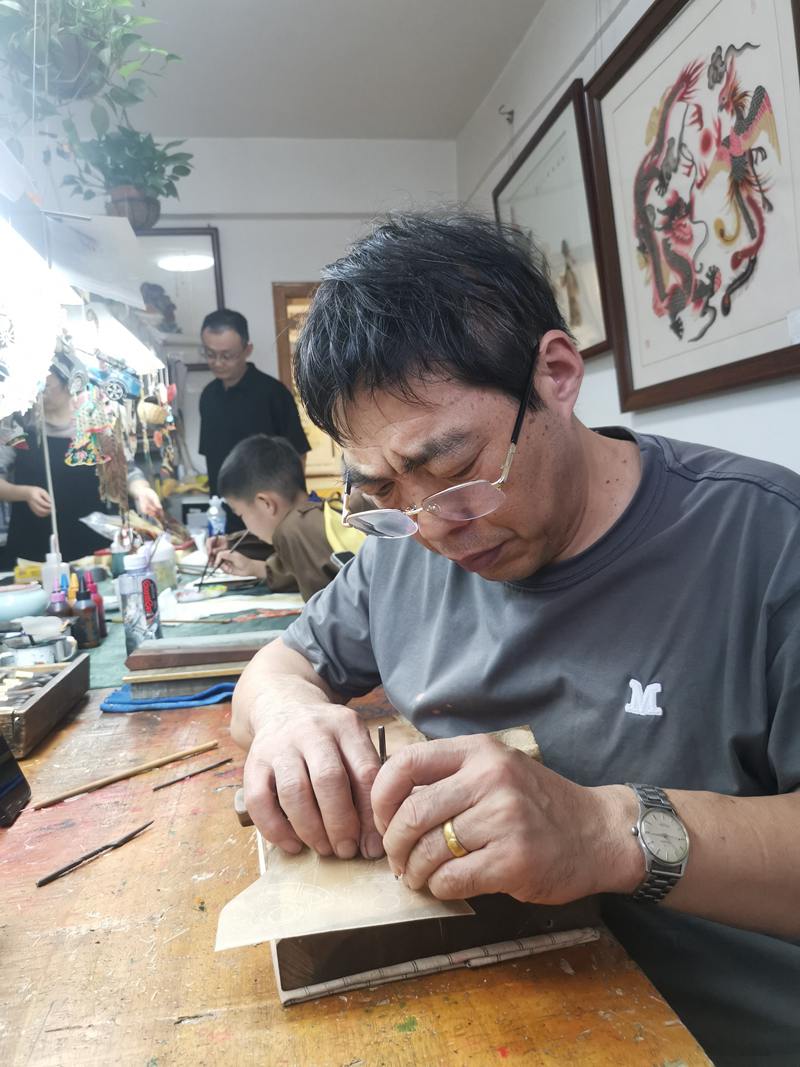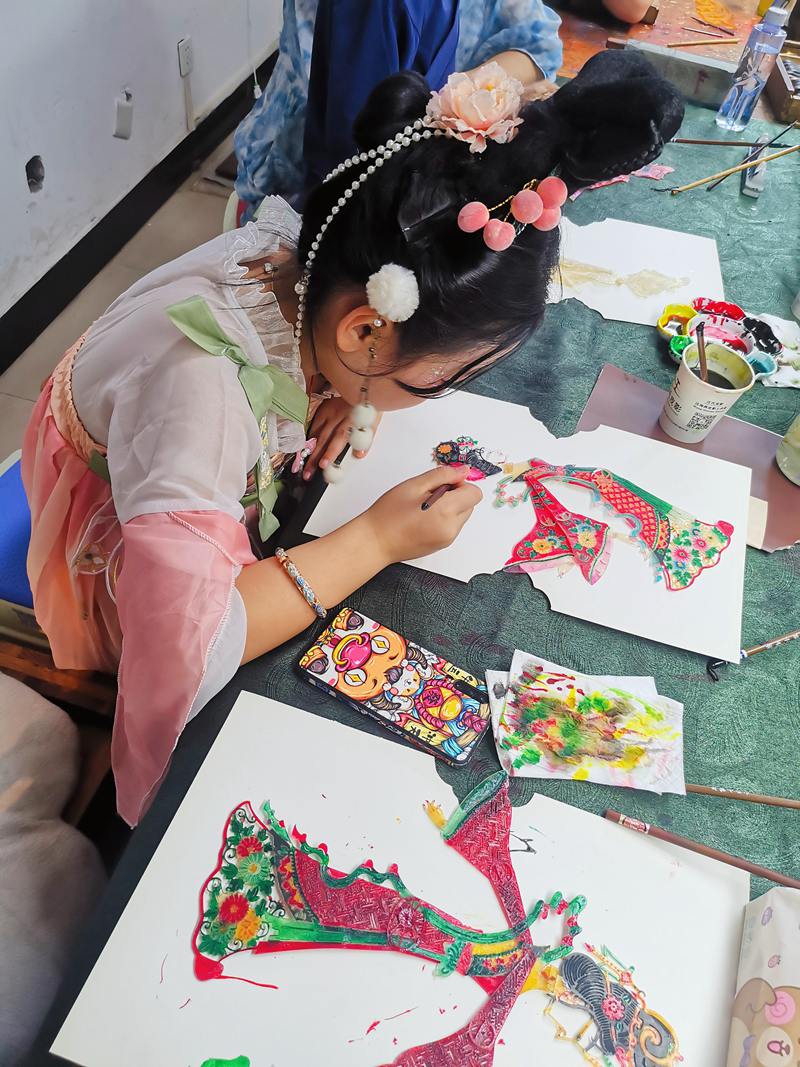Centuries-Old Chinese Shadow Puppetry Glows with New Vigor in Villages in NW China's Shaanxi
Huazhou shadow puppetry in Huazhou District, Weinan City, northwest China's Shaanxi Province, a treasure of Chinese folk art that dates back over 2,000 years, has emerged more appealing and opened up great prospects for rural revitalization, thanks to local inheritors' efforts to pursue innovation-driven development of the traditional form of art.
Originating in the Western Han Dynasty (202 B.C.- 8 A.D.), Chinese shadow puppetry enjoyed a period of great prosperity during the Ming and Qing Dynasties, when regional schools of the folk art were formed.
 |
| Children make shadow puppets under the guidance of shadow puppetry masters in Huazhou District, Weinan City, northwest China's Shaanxi Province. [People's Daily Online/Wang Li] |
Huazhou shadow puppetry is known for its ingenious and graceful designs, delicate and diverse carvings, vibrant colors, and expressive and melodious singing.
With people's ways of entertainment being diversified with each passing day, Chinese shadow puppetry gradually faded away over the past century. Just like any other branch of Chinese shadow puppetry, Huazhou shadow puppetry hasn't caught a lot of attention in the modern society until China designated it as national intangible cultural heritage in 2006 and Chinese shadow puppetry was inscribed on the UNESCO Representative List of the Intangible Cultural Heritage of Humanity in 2011.
Riding on the wave of nationwide efforts to promote intangible cultural heritage protection, Yingtaogou Village in Liuzhi Township, Huazhou District, breathed new life into Huazhou shadow puppetry.
By integrating Huazhou shadow puppetry into its rural revitalization endeavor, the village has effectively boosted the development of local industries and enhanced social etiquette and civility while adding new charm into the ancient art form.
Wang Tianxi, an acclaimed provincial-level representative inheritor of Huazhou shadow puppet-making craft, has played a key role in reviving the traditional folk art.
He has taught shadow puppet-making techniques to his family and many fellow villagers. Five members of Wang's family work in Huazhou shadow puppetry-related industries. His daughter, Wang Yanni, has witnessed how the folk art has broadened Yingtaogou Village's path to rural revitalization.
According to Wang Yanni, in September 2018, Yingtaogou Village offered a couple of rooms free of charge to help protect and inherit Huazhou shadow puppetry. The rooms have been used as venues for various activities related to the protection and inheritance of the folk art, including shadow puppet designing and carving, skills training, and live performances.
"We have set up a professional shadow puppetry cooperative, which has attracted more villagers to the industry. The cooperative is responsible for obtaining orders and selling shadow puppets, while villagers make them to increase their income. The cooperative also provides technical guidance for some people who have started their own businesses," said Wang Yanni.
"We have also embedded the puppet-making experience in academic research tours, and charge each student 68 yuan ($9.33) to 128 yuan. This can also help increase the income of local people," she added.
 |
| A student colors shadow puppets in Huazhou District, Weinan City, northwest China's Shaanxi Province. [People's Daily Online/Wang Li] |
As a result of villagers' efforts led by Wang's family, Huazhou shadow puppets have sold well at home and abroad, and Yingtaogou Village has been designated as a provincial-level demonstration village for carving techniques and a demonstration base for the cultural industry.
Today, more than 300 local residents of Yingtaogou Village work in the shadow puppetry industry, with their per capita average annual income reaching 10,000 yuan. The booming shadow puppetry-related businesses in Yingtaogou Village have even driven the prosperity of shadow puppetry in Liuzhi Township as well as Huazhou District.
"I can take care of my family while carving shadow puppets during my spare time from farming," said a local villager named Zhang Xiaoling, who has shaken off poverty by carving shadow puppets.
With earnings from her shadow puppet works, Zhang has not only built a new house, but bought a car.
In an effort to attract modern audiences, especially young ones, local shadow puppetry artists have innovated the traditional folk art by adding modern elements to the art and leveraging new technologies in shadow puppetry plays.
Xue Hongquan, a villager from Huazhou District, has learned shadow puppetry from his brother-in-law Wang Tianxi since he was 14. Xue is now both an inheritor and an innovator in the craft. He has integrated various modern art forms, such as dance, melodrama, and animation, into shadow puppetry plays, increased the size of shadow puppets from around 30 centimeters to about 70 centimeters, and added movable joints so that shadow puppets can perform 80 percent of human actions.
In 2015, Xue set up a team comprised of post-80s and post-90s people, who have created more than 10 modern shadow puppetry plays. In 2023, the team created a shadow puppetry featuring Ne Zha, a Chinese mythical figure known for its rebellious spirit, which blended shadow puppetry and animation as well as film and television elements. The new play became a hit as soon as it was staged.
"To sustain this intangible cultural heritage, we need to add modern elements and appeal to today's audiences," said Xue.
The integration of shadow puppetry with various industries has brought international attention to the traditional folk art. In 2020, Huazhou shadow puppetry was registered as an international trademark in France. The following year, Huazhou District was designated as the "hometown of Chinese folk culture and art (shadow puppetry)."
More efforts have followed to further promote the protection of this intangible cultural heritage. Shaanxi Province has established training programs to boost the Huazhou shadow puppetry industry, while Huazhou District introduced shadow puppetry performances into the local Shaohua Mountain National Forest Park, attracting over 100,000 visitors.
So far, more than 3,000 residents of Huazhou District are employed in the Huazhou shadow puppetry industry, with the annual output of the industry reaching 30 million yuan.
(Source: People's Daily Online)
Please understand that womenofchina.cn,a non-profit, information-communication website, cannot reach every writer before using articles and images. For copyright issues, please contact us by emailing: website@womenofchina.cn. The articles published and opinions expressed on this website represent the opinions of writers and are not necessarily shared by womenofchina.cn.








 WeChat
WeChat Weibo
Weibo 京公网安备 11010102004314号
京公网安备 11010102004314号